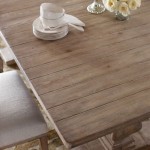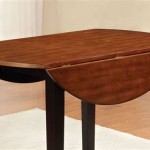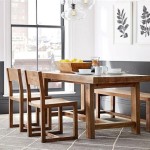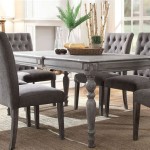Hydrangea Centerpiece for Dining Table: A Comprehensive Guide
A centerpiece serves as a focal point for a dining table, enhancing the overall aesthetic appeal of the space and contributing to the ambiance of meals and gatherings. Hydrangeas, with their voluminous blooms and diverse color palette, are a popular choice for creating elegant and eye-catching centerpieces. This article provides a comprehensive guide to utilizing hydrangeas in dining table centerpieces, covering aspects such as flower selection, design principles, arrangement techniques, and maintenance to ensure a long-lasting and visually stunning display.
Selecting the Right Hydrangeas
The success of a hydrangea centerpiece begins with selecting the appropriate blooms. Several factors influence this decision, including the size of the dining table, the desired style, and the longevity of the flowers. Hydrangea varieties vary in size, color, and stem strength, so careful consideration is required to choose those best suited for the intended purpose.
Firstly, the size of the hydrangeas must be proportional to the dining table. For smaller tables, smaller hydrangea heads, such as those found on lacecap varieties, are more suitable. Larger dining tables can accommodate more substantial mophead hydrangea blooms. Overly large flowers on a small table can overwhelm the space and impede conversation, while undersized blooms on a large table may appear insignificant.
Secondly, the color of the hydrangeas should complement the existing décor of the dining room. Hydrangeas come in a range of colors, including white, pink, blue, purple, and green. Neutral colors like white and green are versatile and can blend seamlessly with most color schemes. Pink and blue hydrangeas can add a pop of color and are often chosen to coordinate with existing textiles or artwork. Color theory suggests considering complementary or analogous color schemes to create a harmonious visual effect. For instance, blue hydrangeas can be paired with yellow accents, while pink hydrangeas work well with green accessories.
Thirdly, stem strength is a crucial consideration. Hydrangeas have relatively delicate stems, which can droop under the weight of the flower heads, especially after being cut. Choosing varieties with thicker, sturdier stems, such as some of the oakleaf hydrangeas, can help to prevent drooping. In addition, proper hydration techniques, discussed later, are essential for maintaining the turgidity of the stems. If using hydrangeas with weaker stems, consider providing support through floral foam or strategic placement within the arrangement. Furthermore, it’s essential to source hydrangeas from a reputable florist or garden center to ensure that the flowers are fresh and have been properly cared for.
Principles of Hydrangea Centerpiece Design
Creating a visually appealing hydrangea centerpiece involves understanding and applying fundamental design principles. These principles govern the arrangement of elements within the composition, ensuring balance, harmony, and visual interest.
Balance is a key aspect of centerpiece design. It refers to the visual equilibrium of the arrangement, creating a sense of stability and harmony. There are two primary types of balance: symmetrical and asymmetrical. Symmetrical balance involves arranging identical elements on either side of a central axis, creating a formal and traditional look. Asymmetrical balance, on the other hand, achieves balance through the placement of different elements on either side of the central axis, creating a more informal and dynamic appearance. For a dining table centerpiece, asymmetrical balance can be particularly effective, as it avoids the rigid formality of symmetrical arrangements while still maintaining visual equilibrium.
Proportion refers to the relative size and scale of the different elements within the centerpiece. It is essential that the flowers, foliage, and vase are appropriately sized in relation to each other and to the dining table itself. Overly large vases or disproportionately small flowers can disrupt the visual harmony of the arrangement. A general guideline is to keep the height of the centerpiece no more than one-third of the width of the table to avoid obstructing views across the table. Additionally, ensuring the blooms themselves are proportionate to the vase, neither overwhelming nor being dwarfed by it, is crucial for a balanced aesthetic.
Unity refers to the coherence and cohesiveness of the centerpiece as a whole. All the elements should work together to create a unified and harmonious composition. This can be achieved by using a consistent color palette, similar textures, or a recurring motif. For example, incorporating foliage with a similar leaf shape or varying shades of the same color can create a sense of unity within the arrangement. In contrast, using too many disparate elements can result in a chaotic and disjointed appearance. Adding elements that relate to a particular theme or event also aids in achieving unified aesthetics. For instance, adding seashells to a hydrangea arrangement creates a coastal aesthetic for a summer gathering.
Rhythm refers to the visual flow of the centerpiece, guiding the viewer's eye through the arrangement. This can be achieved by repeating elements, creating a sense of movement, or using contrasting textures. For example, alternating between large and small hydrangea blooms, or incorporating foliage with varying textures, can create a dynamic and engaging visual rhythm. Varying the height and spacing of the blooms also contributes to the overall rhythm of the centerpiece. Careful planning of rhythm contributes to a visually appealing design that holds the viewer's attention.
Techniques for Arranging Hydrangea Centerpieces
The specific techniques used to arrange hydrangeas in a centerpiece can significantly impact the final result. These techniques involve preparing the flowers, selecting appropriate vases and containers, and employing various methods to maintain the freshness and longevity of the arrangement.
Proper preparation of the hydrangeas is crucial for maximizing their lifespan. Begin by cutting the stems at a 45-degree angle with a sharp knife or floral shears. This increases the surface area available for water absorption. Immediately after cutting, place the stems in a bucket of cool water. Hydrangeas are particularly prone to wilting, so it is beneficial to submerge the entire flower head in water for about 30 minutes to rehydrate the petals. Some florists also recommend dipping the cut ends of the stems in alum powder or using a hydrating solution specifically designed for hydrangeas. Removing leaves from the portion of the stem that will be submerged in water is vital as this prevents bacterial growth, which can clog the stems and hinder water uptake. Recutting the stems every few days extends the flowers' life by preventing them from sealing over.
The selection of a suitable vase or container is another important consideration. The vase should be proportionate to the size of the hydrangeas and the dining table. Clear glass vases are a popular choice, as they allow the stems to be visible, adding to the overall visual appeal. However, opaque vases can also be used, particularly if the stems are not aesthetically pleasing or if the arrangement requires a more formal look. The vase's shape also impacts the design. A wide-mouthed vase allows for a fuller, more abundant arrangement, while a narrow-necked vase encourages a more structured and vertical display. The chosen vase's color and texture should complement the hydrangeas and the surrounding décor, avoiding any clashing styles or colors. Other containers, such as bowls, baskets, or even repurposed items, can be used to achieve a more rustic or unique look.
There are several techniques to assist in the arrangement. Floral foam can provide support for the hydrangeas, allowing for precise placement and stability. Floral foam should be thoroughly soaked in water before use. Alternatively, a grid of floral tape can be created across the top of the vase to hold the stems in place. Another technique is to create a base of foliage, such as eucalyptus or ferns, to provide a foundation for the hydrangeas. Start by placing the larger hydrangea blooms in the vase, followed by the smaller blooms and foliage. Vary the height and placement of the flowers to create a visually interesting arrangement. Consider the view from all angles of the dining table to ensure that the centerpiece looks balanced and appealing from every perspective. Twisting and turning the arrangement while building it facilitates a more comprehensive understanding of how it will appear from different angles. Finally, ensure the vessel has sufficient support to remain stable, even when weighed down with water and flowers.
Maintaining Hydrangea Centerpieces
Proper maintenance is essential for prolonging the life of a hydrangea centerpiece and keeping it looking its best. Regular care ensures that the flowers remain hydrated, vibrant, and free from decay.
One of the most critical maintenance tasks is to replenish the water in the vase regularly. Hydrangeas are thirsty flowers and require a constant supply of water. Check the water level daily and add fresh water as needed. It is also beneficial to change the water completely every two to three days to prevent bacterial growth. When changing the water, recut the stems at a 45-degree angle to remove any blockage and promote water uptake. Adding a floral preservative to the water can also help to extend the life of the hydrangeas by providing nutrients and inhibiting bacterial growth. Some preservatives are specifically formulated for hydrangeas. Adding a small amount of bleach to the water is also an effective way to prevent bacterial growth, however, it’s crucial to avoid using too much as it can damage the flowers. A few drops will suffice.
Another important maintenance task is to remove any wilting or decaying leaves and petals. These can contaminate the water and accelerate the decay of the remaining flowers. Regularly inspect the hydrangeas for signs of wilting, browning, or discoloration. Gently pluck off any affected leaves or petals. If an entire flower head is wilting, remove it from the arrangement to prevent it from affecting the other flowers. Periodically misting the hydrangeas with water can also help to keep the petals hydrated and prevent them from drying out. However, avoid over-misting, as this can promote fungal growth. Using a mister with a fine spray setting is crucial to deliver a gentle amount of moisture. Position the centerpiece away from direct sunlight and heat sources because these can accelerate the wilting process. Cooler temperatures will help to prolong the life of the hydrangeas.
Reviving hydrangeas that have begun to wilt can sometimes be achieved through simple methods. One effective technique is to re-submerge the entire flower head in cool water for about 30 minutes, similar to the initial preparation. This allows the petals to rehydrate and regain their turgidity. Another technique is to prick the stem just below the flower head with a pin or needle. This can help to break any air bubbles that may be blocking water uptake. If these methods do not work, it may be necessary to replace the wilting hydrangeas with fresh ones to maintain the overall appearance of the centerpiece. Even with careful maintenance, hydrangeas are relatively short-lived flowers. Expect them to last for about five to seven days, depending on the variety and the environmental conditions.

Farmhouse Hydrangea Centerpiece Liz Marie Blog

Easy Hydrangea Centerpiece Saw Nail And Paint

Farmhouse Hydrangea Centerpiece Liz Marie Blog

Natural Fall Dining Room Tour Stonegable

Hydrangea Arrangement Farmhouse Centerpiece Dining Table Candle Dough Bowl Rustic Floral Faux Etsy
:max_bytes(150000):strip_icc()/PhotobyLauraGordonPhotography-d6f6cf3ac4b54e08aff1edb75294669e.jpg?strip=all)
28 Best Hydrangea Centerpieces For Your Wedding

Farmhouse Hydrangea Centerpiece

Hydrangea Flower Arrangement Magnolia And Citrus

How To Decorate With Hydrangeas Thistlewood Farm

How To Make A Low Hydrangea Centerpiece Grow Beauty With Ease








